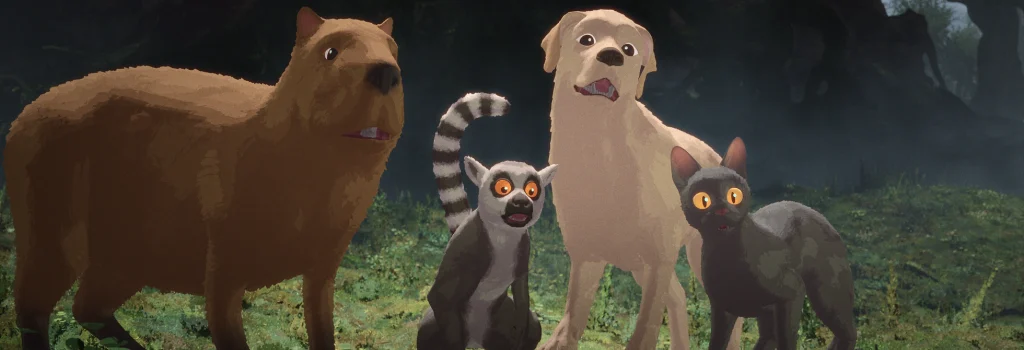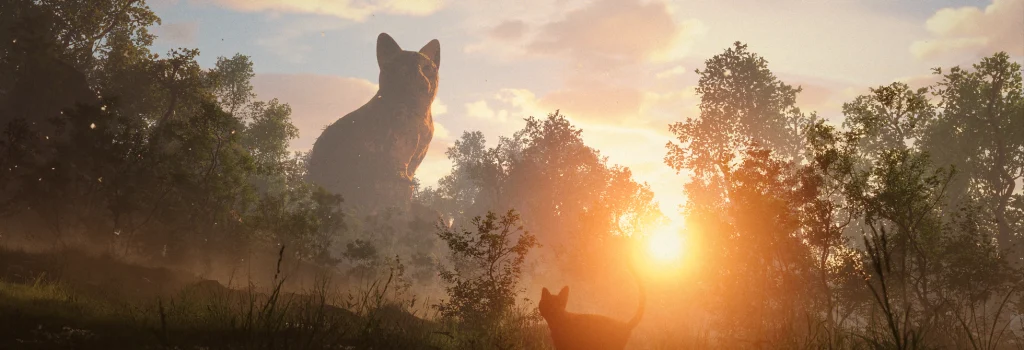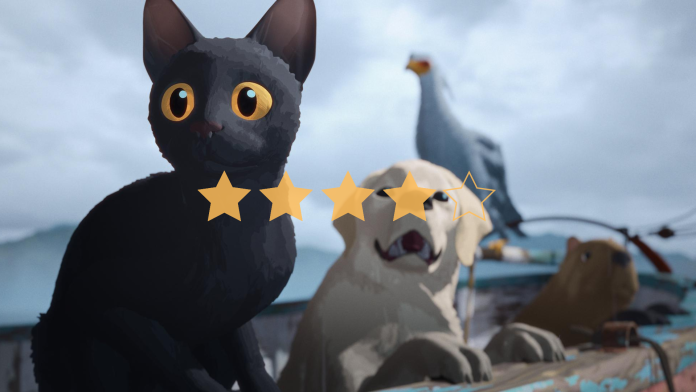Directed and co-written by Gints Zibalodis, Flow was part of the Un Certain Regard section at the 2024 Cannes Film Festival but the film has been in development since 2022. After so much waiting, is Zimbalodis’ newest film worth it? The initial reaction from Cannes would seem to suggest so.
★★★★☆
Set in a world devastated by floods, Flow follows a solitary cat who escapes a flood after his home is destroyed. In this post-apocalyptic landscape, animals of all different species are left to fend for themselves and must find refuge on boats. Here, the cat finds other lonely animals, such as a giant and initially threatening bird, a friendly Labrador, and a lemur who is determined to collect every shiny object he sees. Despite initial struggles, the group eventually manages to get along and fight for survival together.
With a unique animation style and simple but effective worldbuilding, Flow is one of those films that grabs your attention from the moment it starts. The animation style is not only beautiful to look at but is technically impressive too, with a unique 3D animation and handheld camera-like movements that immerse the audience in the film’s world. With its vibrant colours and underwater shots, the film feels very unique in its setting that viewers are immediately immersed in. While the audience doesn’t know very much about this flood or what caused it, the setting is presented to us from the very first shot, making the stakes very clear and urgent.
It is very refreshing to see animals in animation—or films in general—not being humanised with speech. Flow is perhaps one of the first times in which animals on the big screen are portrayed as they are, moving as animals, and making animal sounds. For instance, with the exception of 101 Dalmatians and Bambi where the dogs do not speak but still exhibit human emotions, every Disney cartoon with an animal as the main character humanises them, from The Lion King or The Jungle Book to more recent examples like Zootropia or Ratatouille. This is also true of animation films outside of Disney or Pixar: in Happy Feet, the penguins and every other species are anthropomorphised in their speech and behaviours.

It is also fascinating how the characters’ relationships with each other are portrayed in Flow. Their personal characteristics remain, but by the end of the film they learn to work together and play to each other’s strengths, building a community that can survive and thrive together. It is a powerful message for the viewers, suggesting that unity and community can be the strongest allies in the face of adversity: a lone animal—or person for that matter—may perish, but the group will survive.
There is no dialogue in the film, yet we understand everything about its plot and characters thanks to the editing and soundtrack. The latter is particularly important, helping us to understand the characters’ feelings and emotions and driving the plot forward. Even if the animals in Flow don’t speak or act like humans at all, they are still characters the audience can identify with. As the movie goes on, viewers can see themselves in the solitary nature of the cat, the friendly attitude the dog exhibits, or even in the lemur’s need to keep every object they come in contact with.

The mirror that the lemur steals that repeatedly comes up throughout the plot. Mirror shots are particularly interesting in movies as it is, often offering the audience the possibility to identify themselves with the characters looking in the mirror. However, in Flow it is even more fascinating as it portrays the lemur—and other animals—getting familiar with a mirror, a very human object.
As Flow goes on, the audience also sees the animals look into the mirror and learn to recognise their own their own reflection. This may suggest that they are possibly understanding the concept of the self, something that is currently being studied and observed with the mirror test in animal psychology. Perhaps that is why they learn how to work with each other by the end of the film: once the animals are able to see themselves as sentient beings, they can see others in the same way and build more lasting and deeper bonds with one another.
The Verdict
Flow’s message of friendship and unity in the face of hardship is beautiful, and one that both children and adults in the audience will be able to appreciate. Flow is very likely the best animation film of 2024, if not one of the best of recent years, thanks to its incredible visuals and unique storytelling style.
Flow premiered at the Cannes Film Festival on 22 May 2024
Words by Clotilde Chinnici
Support The Indiependent
We’re trying to raise £200 a month to help cover our operational costs. This includes our ‘Writer of the Month’ awards, where we recognise the amazing work produced by our contributor team. If you’ve enjoyed reading our site, we’d really appreciate it if you could donate to The Indiependent. Whether you can give £1 or £10, you’d be making a huge difference to our small team.
